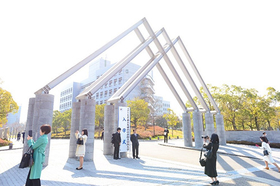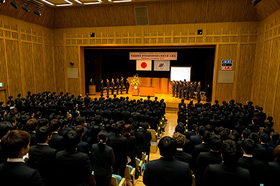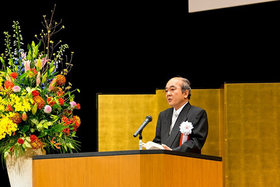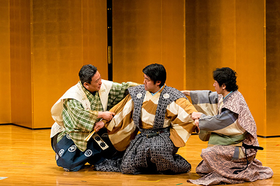2017/04/10
On Wednesday, April 5, 2017, an entrance ceremony was held in the Millennium Hall.
NAIST eagerly promotes admission of students whether from Japan or overseas with strong basic academic capabilities without being bound to a major field in university as well as researchers, engineers and others currently working actively in society who have clearly defined goals and aspirations for the future as well as strong interest and enthusiasm for research fields. This spring 420 graduate students were granted admission to NAIST.
At the ceremony, Mr. Jun Hitotsumatsu, the Vice Governor of Nara Prefecture, Mr. Masashi Komurasaki, the Mayor of Ikoma City, Dr. Makoto Nagao, the Director of International Institute for Advanced Studies, Mr. Shigekazu Nakamura, the Executive Director of the Foundation for NAIST, Dr. Shoji Komai, the Head of NAIST Alumni Association were invited as guests. There was a performance of "Kuchimane", Okura School of Kyogen by the Shigeyama Family.
*Number of Enrollees in April
【Master's Course】
Information Science 135 (5 international students)
Biological Sciences 131 (2 international students)
Materials Science 94 (2 international students)
【Doctoral Course】
Information Science 29 (8 international students)
Biological Sciences 16 (2 international students)
Materials Science 15 (2 international students)
Total 420 (21 international students)
Congratulatory Remarks to Entering Students
At Entrance Ceremony, Spring 2017
I would like to extend my heartfelt congratulations to the 360 master's program students and 60 doctoral program students who enter NAIST today. On behalf of the 200 faculty and 150 staff members of NAIST, I welcome you all. I would like to express my congratulations to the families of the students, as well.
The new students who enter NAIST today include 21 students from 10 countries around the world. I would like to warmly welcome you, the international students, who have chosen to study at NAIST, away from your home countries. With your entrance, we have a total of 212 international students from 28 countries.
NAIST aims to increase its international student population to more than 300 students from more than 40 different countries to achieve an education and research environment where international students are studying and contributing in all of the 60+ main laboratories here, and I feel we are coming very close to realizing this goal.
NAIST celebrated its 25th anniversary last year. First, I would like to explain the background of NAIST's foundation. In the concept paper for NAIST's establishment, the guiding mission of our research is described as:
"Characteristically, the fields of frontier science and technology have wide-ranging, interdisciplinary dimensions in which innovative developments are taking place at a very rapid pace. In these fields, new knowledge from fundamental research results in technological developments in very short periods, and technological developments, in turn, become the base of fundamental research and make further progress possible.Thus, high integration of science and technology is remarkably more notable than in any other field. With this in mind, it is crucial to promote interdisciplinary fundamental research that reaches beyond traditional academic divisions in these fields."
The education mission of NAIST is explained as follows.
"With the rapid developments in the areas of frontier science and technology, an important issue for both academic research and industry is the organized fostering of researchers and engineers capable of undertaking research and development in these fields. Especially in these fields, it is necessary to train diverse human resources with refined fundamental skills to respond flexibly to developments in science and technology, and to continuously pursue new fields of research."
To sum up, NAIST was founded to conduct interdisciplinary research in rapidly developing fields of frontier science and technology such as information, biological and materials sciences, by integrating science and technology and extending beyond the borders of established study areas such as engineering, physical science, agriculture and medical science. With this as our foundation, NAIST develops human resources capable of flexibly responding to developments in science and technology, and continually cultivating new areas of research.
NAIST's current education and research mission has since been revised to include the keyword "to see [issues] from a global perspective." The mission was pioneering from the outset and continues to represent the ideas necessary for society today. With dynamic research in academia, research institutes, and private industry by faculty members from various backgrounds, and through organized graduate school education based on cutting-edge research, NAIST has produced 7,265 master's and 1,402 doctoral graduates.
NAIST's research and educational activities have been evaluated very highly both in objective rankings and in the Ministry of Education, Culture, Sports, Science and Technology's (MEXT) evaluation of national university educational and research results. For example, MEXT is has been offering intensive support to 22 Japanese institutions with a track record of outstanding research under its Program for Promoting the Enhancement of Research Universities since 2013 in order to strengthen research prowess. NAIST was one of the institutions chosen.
In addition, Japanese universities had previously tended to focus domestically, but today internationalization of higher education is strongly being called upon to view the future of the world, ensuring more students and researchers from around the world will study at Japanese universities and learn about Japanese science and technology, while Japanese students are exposed to the demands placed on science and technology at the global level and to the societies of various countries. For this, MEXT launched the program called the Top Global University Project in 2014. This project is designed to provide priority support for selected universities that focus on increasing their international competitiveness, and I am pleased to note that NAIST is a participating university.
I am proud to add that we are one of only 17 Japanese universities selected for both the Program for Promoting the Enhancement of Research Universities and the Top Global University Project.
You should be proud of being members of one of the most prestigious universities in Japan in terms of both research and education, and I urge you to take advantage of the valuable opportunities available at NAIST in furthering your academic career and workforce preparation.
Closely related to our educational and research mission I mentioned before, science and technology today is changing dramatically and it can be said that we are in a revolutionary era of science and technology. New keywords in science and technology are artificial intelligence (AI), big data, and the Internet of Things (IoT), and are mainly thought to be related to information science.
Thanks to computer, sensor and network efficiency improvement, cars and all kinds of things are connected to the internet making the entire world interconnected in real time, and we are facing an era where integrated data use around the world is possible.As a result, we can also see the rise of a 'Super Smart Society' which effectively and thoroughly responds to the various needs of society in offering the necessary materials or services to the necessary people at the necessary time in the necessary amount.
These kinds of changes in societal infrastructures greatly influence research methodology and its applicable fields not only in the area of information science, but in all research areas. For example, in the field of biosciences, revolutions in areas such as genome DNA sequence analysis technology and cellular activity imaging technology have brought forth an era where collecting huge amounts of data on the activities of various cells and living organisms within nature, including humans, is possible. The interdisciplinary field of big data technology which is closely related to information science, has been created. Also, in the field of materials science, material informatics, a new interdisciplinary field with information science, is emerging; and there are growing expectations towards pursuits for new material creation with effective molecular and material design using AI functions. Furthermore, progress in cutting edge medical science is expected through the connection of developments in the construction of medical databases and remote operation technology utilizing virtual and augmented reality in information sciences, the development of embedded biodevices utilizing element microminiturization and flexible biocompatible materials in materials science, and the advancements of developmental and cellular biology within bioscience.
As demonstrated by this, within the revolutions of science and technology developments towards the interdisciplinary fields that span the 3 main advanced science and technology areas at NAIST, information, biological and materials sciences, are becoming very prominent.
With this, of course, researchers and technicians in these interdisciplinary fields will come to be in great demand.
It is thought that revolutions in science and technology will not stop within research but bring about large changes to society and mankind. A major example of this is the achievement of computer abilities that surpass our own, or 'singularity.' This is a phenomenon advocated by Ray Kurzweil and is referred to as technical singularity or technical limitation, and, as we near singularity, it is predicted that many of the occupations at that time will be lost and new occupations will appear. If the prediction that singularity will occur in the 2040's is correct, then, at that time, you should be the generation leading societal growth and evolution.
In considering future societal developments and changes at the forefronts of science and technology, NAIST is planning to unify the three current graduate schools into a one graduate school system in 2018 to radically enhance interdisciplinary area education programs. You have all left your previous places of study and I believe you are entering NAIST with high expectations for your future experiences here.
After this you will be introduced to the laboratories at each graduate school and then decide which laboratory you will belong to. Please do not limit yourself to your previous knowledge and experience, but instead take a large step forward and challenge yourself to unlock new possibilities.
Remember, NAIST's motto is 'Outgrow your Limits.'
Looking towards the future, at NAIST I hope you equip yourself with the basic tools that will allow you to not depend solely upon the knowledge and skills of only one area of specialization, but instead apply those methods to other fields to pursue new areas of research and rise above singularity.
Finally, I hope you will enjoy your life at NAIST in good health. You will meet many new people here at NAIST and I hope that you will treasure these friendships. This network of friends will not only widen your research and academic activities, but also become a priceless part of your entire life.
In concluding my message, I hope you will have a successful student life and have great expectations for your future activities.
Congratulations once again on entering NAIST.
April 5, 2017
Naokazu Yokoya,
President
Nara Institute of Science and Technology








